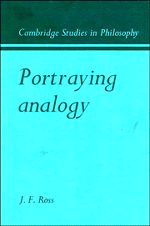Book contents
- Frontmatter
- Contents
- Dedication
- Preface
- Introduction
- 1 The limitations of classical analogy theory and the Miller's Analogies transition
- 2 The genus: meaning differentiation
- 3 Predicate schemes: an explanatory model
- 4 Equivocation, analogy and metaphor
- 5 Denominative analogy and paronymy
- 6 Figurative discourse
- 7 Analogy and religious discourse: craftbound discourse
- 8 Analogy and analysis
- Notes
- Bibliography
- Name index
- Subject index
Introduction
Published online by Cambridge University Press: 07 October 2011
- Frontmatter
- Contents
- Dedication
- Preface
- Introduction
- 1 The limitations of classical analogy theory and the Miller's Analogies transition
- 2 The genus: meaning differentiation
- 3 Predicate schemes: an explanatory model
- 4 Equivocation, analogy and metaphor
- 5 Denominative analogy and paronymy
- 6 Figurative discourse
- 7 Analogy and religious discourse: craftbound discourse
- 8 Analogy and analysis
- Notes
- Bibliography
- Name index
- Subject index
Summary
Why look for a systematic account of the meaning relationships different tokens of the same word have to one another (drop/stitch, drop/friend, drop/hint) when hardly anyone seems to have missed having one for five hundred years?
First, something with comprehensive philosophical consequences may have been overlooked. Both Aristotle's and the medieval Aristotelean writers' accounts of analogy (of diverse but related same-word meaning) affected the whole of those philosophies.
Secondly, the linguistic phenomena are pretty much as the classical writers said they were, though their explanation is not right. Such extensive data fairly beg us to probe for the hard bone of law underlying ‘focal meaning’, ‘family resembling terms’, ‘systematically ambiguous expressions’ and the panorama of verbal proportionality, metaphor, denomination and paronymy, remarked by philosophers of all epochs and persuasions.
Thirdly, there is no competitor for the classical account, despite its false foundations, mentioned in the Preface, and its limitations of scope and perspective, described in chapter 1. We need a competing portrayal, preferably one that construes the superficially chaotic data as the logical outcome of simple linguistic universals.
Fourthly, the analogy phenomena require revisions in the philosophy of language and probably in the philosophy of mind as well. A systematic study of same words refutes the assumptions that sentence meanings are the syncategorematic ‘sum’ of independent word/morpheme meanings (like a wall assembled out of varied stones) and that an ideal dictionary would have an entry for every meaning of every word in the language.
- Type
- Chapter
- Information
- Portraying Analogy , pp. 1 - 16Publisher: Cambridge University PressPrint publication year: 1982
- 6
- Cited by



